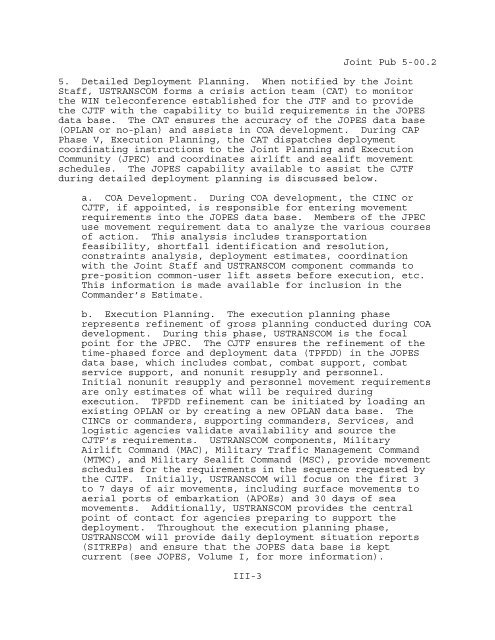JP 5-00.2 Joint Task Force Planning Guidance and Procedures - BITS
JP 5-00.2 Joint Task Force Planning Guidance and Procedures - BITS
JP 5-00.2 Joint Task Force Planning Guidance and Procedures - BITS
You also want an ePaper? Increase the reach of your titles
YUMPU automatically turns print PDFs into web optimized ePapers that Google loves.
<strong>Joint</strong> Pub 5-<strong>00.2</strong><br />
5. Detailed Deployment <strong>Planning</strong>. When notified by the <strong>Joint</strong><br />
Staff, USTRANSCOM forms a crisis action team (CAT) to monitor<br />
the WIN teleconference established for the JTF <strong>and</strong> to provide<br />
the CJTF with the capability to build requirements in the JOPES<br />
data base. The CAT ensures the accuracy of the JOPES data base<br />
(OPLAN or no-plan) <strong>and</strong> assists in COA development. During CAP<br />
Phase V, Execution <strong>Planning</strong>, the CAT dispatches deployment<br />
coordinating instructions to the <strong>Joint</strong> <strong>Planning</strong> <strong>and</strong> Execution<br />
Community (<strong>JP</strong>EC) <strong>and</strong> coordinates airlift <strong>and</strong> sealift movement<br />
schedules. The JOPES capability available to assist the CJTF<br />
during detailed deployment planning is discussed below.<br />
a. COA Development. During COA development, the CINC or<br />
CJTF, if appointed, is responsible for entering movement<br />
requirements into the JOPES data base. Members of the <strong>JP</strong>EC<br />
use movement requirement data to analyze the various courses<br />
of action. This analysis includes transportation<br />
feasibility, shortfall identification <strong>and</strong> resolution,<br />
constraints analysis, deployment estimates, coordination<br />
with the <strong>Joint</strong> Staff <strong>and</strong> USTRANSCOM component comm<strong>and</strong>s to<br />
pre-position common-user lift assets before execution, etc.<br />
This information is made available for inclusion in the<br />
Comm<strong>and</strong>er’s Estimate.<br />
b. Execution <strong>Planning</strong>. The execution planning phase<br />
represents refinement of gross planning conducted during COA<br />
development. During this phase, USTRANSCOM is the focal<br />
point for the <strong>JP</strong>EC. The CJTF ensures the refinement of the<br />
time-phased force <strong>and</strong> deployment data (TPFDD) in the JOPES<br />
data base, which includes combat, combat support, combat<br />
service support, <strong>and</strong> nonunit resupply <strong>and</strong> personnel.<br />
Initial nonunit resupply <strong>and</strong> personnel movement requirements<br />
are only estimates of what will be required during<br />
execution. TPFDD refinement can be initiated by loading an<br />
existing OPLAN or by creating a new OPLAN data base. The<br />
CINCs or comm<strong>and</strong>ers, supporting comm<strong>and</strong>ers, Services, <strong>and</strong><br />
logistic agencies validate availability <strong>and</strong> source the<br />
CJTF’s requirements. USTRANSCOM components, Military<br />
Airlift Comm<strong>and</strong> (MAC), Military Traffic Management Comm<strong>and</strong><br />
(MTMC), <strong>and</strong> Military Sealift Comm<strong>and</strong> (MSC), provide movement<br />
schedules for the requirements in the sequence requested by<br />
the CJTF. Initially, USTRANSCOM will focus on the first 3<br />
to 7 days of air movements, including surface movements to<br />
aerial ports of embarkation (APOEs) <strong>and</strong> 30 days of sea<br />
movements. Additionally, USTRANSCOM provides the central<br />
point of contact for agencies preparing to support the<br />
deployment. Throughout the execution planning phase,<br />
USTRANSCOM will provide daily deployment situation reports<br />
(SITREPs) <strong>and</strong> ensure that the JOPES data base is kept<br />
current (see JOPES, Volume I, for more information).<br />
III-3

















